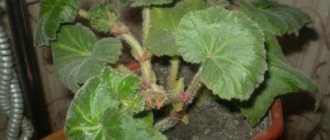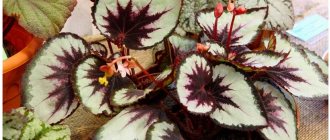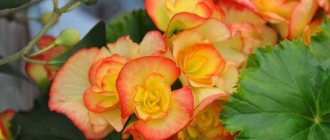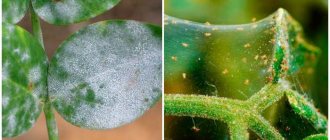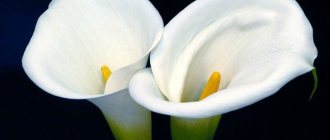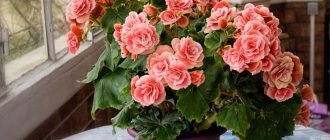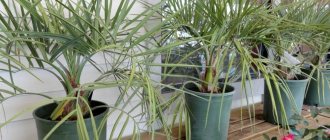The diversity of begonias is amazing: botanists count about 1,600 species, and the number of currently existing cultivated varieties and hybrids is beyond counting (1). The main habitat of begonias in the wild is the tropical rainforests of South America and Africa, as well as the mountainous regions of Asia.
The first representatives of the species were described by the French monk-researcher Charles Plumier during an expedition to the islands of the Antilles archipelago. The organizer of the expedition was the quartermaster of the French fleet in Marseille, Michel Begon, in whose honor Plumier named the new genus of plants he discovered.
Begonia has been cultivated since the 19th century, and the appearance of the first hybrid varieties dates back to the same time. There are not only indoor, but also garden varieties of begonias that are grown in open ground (2).
Types of indoor begonia
As mentioned above, the number of species, varieties and hybrids of begonia is very large, so their classification causes difficulties even for specialists (2). According to the nature of the growth of the above-ground part, begonia species can be divided into herbaceous, subshrubs and liana-like (ampeloid). According to the characteristics of the development of the root system - rhizomatous and tuberous. According to decorative properties - flowering and decorative foliage (3). It is clear that it is not possible to list all types of indoor begonias here, so it makes sense to mention only the most common ones.
Decorative foliage
Royal begonia (Begonia rex). A species with leaves that are irregularly heart-shaped or curled at the base in the form of a “snail,” glabrous or slightly pubescent. With a typical plant height of 40 - 50 cm, the leaf plate can be up to 30 cm long and up to 20 cm wide, but more compact varieties of this begonia are popular among gardeners. The palette of colors of royal begonia leaves is huge: there are all kinds of transitions of green, red, crimson, brown and even silver tones; there are varieties of begonia with almost black, speckled, edged leaves. The flowering of this begonia is inconspicuous.
Popular varieties:
- Merry Christmas - with soft transitions of cherry, pink, emerald and silver tones;
- Evening Glow - the middle of the leaves is bright crimson, towards the edge the shade turns into silver with a dark reddish border;
- Escargot is an unusual variety with a very pronounced “snail” shape of the leaf, spirally twisted towards the petiole, the shade of the leaves changes from dark green in the center through a wide silver stripe to green-olive at the edge;
- Hallelujah (Hallelujah) – leaves have a pointed shape with a moderately pronounced “snail-like” appearance, the core and border of the leaf are red-violet, between them there is a green leaf with silver inclusions;
- Inca Night is a very bright variety with pointed leaves of a rich red color with a very dark brown border.
Begonia regal Merry Christmas. Photo: pixabay.com
Begonia royal Hallelujah. Photo: pixabay.com
Bauer's begonia, or tiger begonia (Begonia bowerae). Compact begonia (up to 25 cm) with medium-sized rounded leaves of spotted color, which have pubescence on the back side and sparse “hairs” along the edges. The shoots are creeping, so the plant can be grown in hanging pots. The flowers are unremarkable.
Varieties:
- Cleopatra - with pointed “star-shaped” leaves of a dark green color with noticeable pubescence on the outside, which gives the leaf a silvery tint;
- Tiger - leaves are round, with dark brownish veins and light green spaces, the plant is compact, shoots rarely reach a length of more than 15 cm.
Metal begonia (Begonia metallica). The heart-shaped or pointed leaves of this begonia have a rich green color with a “metallic” tint. A very compact type of begonia with shoots about 10 cm long.
Red leaf begonia, or Fista (Begonia erythrophilla). “Grandma’s” begonia has a very recognizable appearance with round, smooth or slightly folded glossy leaves on dense petioles. The reverse side of the leaves is shiny, dark pink or red. Plant height is up to 25 cm, width is often greater than height.
Begonia Bauer variety Tiger. Photo: commons.wikimedia.org
Blooming
Coral begonia (Begonia corallina). A large shrub-type begonia, reaching a height of 90 - 100 cm. The leaves are oval-pointed, green, with small light specks. This type of begonia blooms beautifully with small pink or red flowers in strongly drooping clusters of inflorescences. There are few varieties; there are varieties of this begonia with serrated leaves, for example, President Carnot.
Begonia coral. Photo: pixabay.com
Ever-blooming begonia (Begonia semperflorens). A shrub up to 60 cm high with abundant and very long flowering; in indoor conditions it can last almost the whole year. The leaves are medium-sized, rounded, the flowers are double, in different shades of pink and red, sometimes white. There are a lot of varieties and hybrids of this begonia, some are compact with larger flowers. It is quite difficult to single out the most popular varieties of this begonia due to their large assortment; new hybrids appear literally every year.
Begonia ever-blooming. Photo: pixabay.com
Begonia elatior, or winter (Begonia x elatior). These plants are sometimes mistakenly classified as a separate species, but in fact Elatior is a group of hybrid begonias of not entirely clear species. This variety of flowering begonias is one of the most popular among flower growers and breeders; its distinctive feature is the ability to bloom in winter. The height of an adult plant is about 30 cm (sometimes up to 40 cm), it forms a dense bush with a “bouquet” appearance. The flowers are small, but very numerous, depending on the variety they vary from simple to densely double. The shades of the flowers are bright and varied, there are only begonias with flowers in cold blue tones. You can find varieties of Elatior begonias with bicolor or edged flowers.
Begonia elatior. Photo: pixabay.com
Photo: pixabay.com
Photo: pixabay.com
or hanging begonia (Begonia pendula). Strictly speaking, this is not a species, but a collective name for a group of begonias with hanging shoots that are grown in pots and hanging baskets. Most often these are begonias with a tuberous root system. Ampelous begonias vary widely in the shape and shade of leaves and flowers; the flowers are most often white, red, pink and yellow, drooping, located at the ends of the shoots. An interesting variety is the Cascade series, which includes plants with double flowers.
Description of the species and varieties
All types of begonias that are grown indoors are divided into decorative flowering and decorative deciduous. The decorative flowering varieties include the following:
- Begonia everblooming;
- Begonia tuberous;
- Begonia Elatior.
There are the following decorative foliage species:
- Begonia royal;
- Begonia Bauer;
- Begonia Mason.
Begonia everblooming is a decorative subshrub. In nature it reaches a height of 0.5 m; in an apartment it is usually even smaller. It has a thick branched stem and smooth leaves of a simple shape. Small flowers are collected in inflorescences on long peduncles. Its flowers have different shades: white, pink, salmon and red.
There are many varieties of ever-blooming begonias with semi-double and double flowers.
Tuberous begonia is a flowering species that forms an underground tuber. Its leaves have an asymmetrical shape, its stems are low and fleshy. It has amazingly beautiful and long-lasting flowering. Here are some popular varieties of tuberous begonia:
- "Arlecin"
- "Marmorata"
- "Skarlet"
Begonia Elatior is a compact perennial plant characterized by lush flowering. Forms flowers in winter. Several varieties of this species:
- "Schwabenland"
- "Annebell"
- "Piccora"
Royal begonia has a short, fleshy and highly branched stem. Large and velvety leaves are attached to it on long petioles. Many varieties of royal begonia have been developed with patterned leaves of various shades:
- "Snail" has curled leaves of a bizarre shape;
- “Cleopatra” is distinguished by its carved black velvet leaves;
- “Griffin” is a variety with carved variegated leaf blades.
Bauer's begonia or tiger begonia is a small herbaceous species. It has short and branched stems. The leaf blades are round, asymmetrical, with a serrated edge. The leaf length is no more than 7 cm. The bush looks very lush and decorative.
Mason's begonia is a compact herbaceous plant with a surprisingly beautiful pattern on the leaves. The bush reaches 20 cm in height. It blooms with inconspicuous small flowers of a greenish tint.
Photos of begonias in the process of care at home and in the garden:
Caring for indoor begonia at home
The difficulty of caring for begonias can vary depending on the species. The easiest to grow are royal begonias, Bauer begonias, red-leaved begonias, everflowering begonias and elatior begonias.
Priming
The soil for begonias should be nutritious, loose, slightly acidic and with good water and air permeability. Experienced gardeners believe that soil requirements differ for flowering, decorative-leaf and tuberous begonias.
When purchasing ready-made soil for decorative deciduous species, it is better to choose a specialized one designed specifically for begonias. You can also plant flowering ones in it, but it is better to look for a special composition for flowering begonias or for other flowering plants with similar requirements for soil characteristics. For tuberous begonia, nutritious soils for flowering indoor plants are suitable, where you can add perlite or vermiculite.
When purchasing, pay attention to the composition of the soil mixture: it is desirable that it contains vermicompost, vermiculite, micro- and macroelements.
Lighting
Begonia prefers bright, diffused light without direct sunlight, which can burn the delicate leaves. For flowering begonias and decorative deciduous varieties with brightly colored leaves, bright light is a must. Metallic, red leaf and coral begonias tolerate some shade. An interesting feature of Elatior begonias is that they bloom only after daylight hours are reduced to 9 hours - which is why they usually bloom in the cold season. In order for the flowering to last for a long time, after the formation of buds it is very important not to move the plant - changing the lighting (up to the angle of incidence of the light rays) leads to a deterioration in flowering.
Humidity
Begonias need moderately humid air. In the warm season (if there is no heat for many days), the level of humidity in a ventilated room is quite sufficient for it. In winter, indoor air is usually dry due to heating devices, so begonias require additional moisture. The best option is a room humidifier. If it is not there, the pot with begonia can be placed in a tray with damp expanded clay, pebbles, moss, sand or other similar material. As a last resort, a wide, low container of water will do, which should be placed near the begonia pot.
Be careful: it is strictly not recommended to spray begonias, as this leads to the appearance of spots on the leaves.
Watering
Correctly adjusting watering is the main difficulty in caring for begonias. They are moisture-loving, but overwatering very quickly leads to rotting of the roots. Overdrying is also dangerous for them, so maintaining optimal soil moisture is very important.
In summer, begonias are watered generously about 2 times a week; in extreme heat, the frequency, but not the volume, of watering is increased. In between waterings, the soil in the pot should dry out, but not dry out completely (you can check this by plunging your finger into the soil: at a shallow depth it should already be wet).
In winter, the frequency and volume of watering for most begonias is approximately halved. For Elatior begonias, during the flowering period, maintain the usual level of soil moisture, and after flowering, watering is reduced so that the soil dries out almost completely, but does not dry out completely. Tuberous begonias with a pronounced dormant period in winter are not watered at all or almost nothing. When watering tuberous begonias, you need to make sure that water does not fall directly on the tuber.
Water for watering begonias must be warm and well-settled. If the tap water in your area contains a lot of lime, this can lead to alkalization of the soil in pots with begonias, so it is recommended to sometimes add a few drops of citric acid to the watering water.
The best time to water begonias is morning. In the warm season, they can be watered in the evening, but not during the day, in the heat.
Begonias benefit from periodic loosening of the soil after watering - this improves air access to the roots. Any water that gets into the tray is drained immediately.
Fertilizers
It is best to use special liquid fertilizers for begonias - they have a balanced composition suitable specifically for this crop. You can also use fertilizers intended for decorative deciduous and flowering indoor plants.
Fertilizers with a large amount of nitrogen are suitable only for begonias with decorative leaves, as they contribute to the formation of green mass. Flowering begonias need compounds with a predominant content of phosphorus and potassium. For flowering begonias, especially Elatior, you can use a long-lasting fertilizer such as tablets or sticks.
Feeding
Begonias are fed during the period of active growth, from April to the end of September, once every 2 weeks, applying liquid fertilizers along with watering. Elatior begonias can be fed somewhat less frequently - once every 3 weeks. Begonias that bloom in winter are fed at this time once a month; after flowering, feeding is stopped.
Since there are many types of begonias, general recommendations may not suit your specific flower, so it is better to start fertilizing with a dosage of 1/2 of the recommended one. With an excess of nitrogen, flowering begonias develop abundant foliage, but the buds do not set.
Shredding, paleness and falling off of healthy leaves, stunting of growth during the active growing season, and dying off of buds may indicate a nutrient deficiency. Monitor your plants and adjust the dose and feeding schedule based on their condition.
Trimming
In bush begonias, it is recommended to pinch the tops of the shoots - this allows you to form a lush bush.
Flowering begonias need to cut off flower stalks after flowering. Elatior begonias go into a dormant period after flowering, and many gardeners practice rather radical pruning of all shoots, which renew themselves after the plant enters the growing season.
Old shoots of many types of begonia tend to become bare, losing leaves, so it is recommended to remove them.
For sanitary purposes, dry and damaged leaves and shoots are removed from all types of begonias.
Transfer
When looking for answers on how to replant or how to grow tuberous begonia at home, you should pay attention to the instructions indicated on the label upon purchase, or consult with experienced flower gardeners on all the nuances of replanting and growing plants.
Is it possible to replant flowering begonia at home? Flowering or non-flowering plants require the same care. They can be replanted for further cultivation in slightly acidic soil, with good air circulation and water permeability. The optimal composition of the mixture for replanting includes 2 parts humus soil, 1 part high-moor peat, 1 part coarse sand.
For transplantation, it is important to take into account the structure of the root system - tuberous, rhizome or root. Tuberous begonia is unpretentious in planting and caring for at home. Rhizome and root require a more careful selection of containers with excellent drainage layer, but it is also important to take into account the fragility of the roots to fracture and, if possible, do not roughly clean them, but transfer them to a new pot with the addition of the mixture on top of the roots of the plant.
Is it possible to replant a flowering begonia after purchasing it in a store at home? Of course yes, especially if you doubt the quality of the soil or notice excess moisture in the pan.
Most of the roots are located in the surface layer and it is better to choose a pot with a wide diameter rather than rely on height indicators. Fertilizer for flowering begonia at home can be purchased specially or prepared independently by adding nutrients to the water for irrigation once every two weeks.
Reproduction of indoor begonia at home
The begonia flower is easily propagated vegetatively - by cuttings, dividing bushes and tubers, and rooting leaves. You can grow begonias from seeds, but the seeds you collect yourself are most often not suitable for this: the most beautiful begonias are usually of hybrid origin, and in hybrids, daughter plants grown from seeds do not inherit parental characteristics.
By cuttings. The simplest and most convenient method, especially since you can use waste from begonia pruning done in spring and early summer.
Cuttings can be obtained from any part of the shoot, the main thing is that they have at least 2 - 3 nodes. Leaves, except the top ones, are removed, the cutting is placed in a glass of water at room temperature and kept in a moderately warm and well-lit place. After the roots appear, the begonia is transplanted into the ground.
You can root cuttings directly in the soil. To do this, the lower part of the cutting is dusted with a root formation stimulator (for example, Kornevin), then the cutting is placed in a moist substrate. The container is covered with a bag or transparent plastic and kept in a warm, bright place, periodically ventilating and, if necessary, moistening the soil. A sign that the cuttings have taken root is the appearance of young leaves. After this, the lid is removed and the plant is cared for as usual.
By division. Practiced for bush and tuberous begonias, it can be combined with spring replanting. Division is useful primarily for overgrown and aging begonia flowers, which are thus rejuvenated.
The plant is carefully removed from the pot, the roots are cleared of soil or, if necessary, lightly washed. The rhizome is cut with a sharp sterilized instrument so that each part has approximately an equal number of strong shoots. The cut is sprinkled with activated carbon or wood ash. Delenki are planted in pots.
The technology for dividing a tuber is almost the same: the tuber is cut so that each part has healthy sprouts, the cut is allowed to dry and sprinkled with coal or ash. After this, the divisions are planted in the ground and kept in a warm, bright place, protected from direct sun.
Leaf. The method is well suited for begonias with short or weak stems.
The propagation leaf is cut off with part of the petiole and placed in a glass of water, which is changed every day. After the roots appear, the leaf is planted in the ground - it will give rise to a whole plant.
Parts of a leaf. A somewhat more labor-intensive method and not always successful, but it allows you to get several plants from one leaf at once.
The leaf is cut and the veins are cut on the reverse side or divided into segments so that on each of them there remains one longitudinal and 2 or more transverse veins. The lower part with the longitudinal vein is buried in wet sand, the container is covered with a transparent lid and kept in a warm, bright place, periodically ventilated. If necessary, moisten the soil with a spray bottle.
Rooting may take up to 3 months. Young plants obtained in this way grow very slowly at first.
Reproduction
Plants can be propagated by cuttings; both leaf and apical cuttings take root well.
Cuttings are cut in May or early June. Their length should not be less than 7-8 cm. They are rooted in water or immediately planted in the ground.
When planting in the ground, it is better to cover the cutting with a glass jar , and keep the soil underneath it moderately moist. Reproduction is possible by dividing the bush when replanting the plant.
Tuberous varieties are propagated by seeds . They are sown in winter in the soil for begonias. The seeds of these plants are small, so they should not be sprinkled with soil. Water the soil with a spray bottle. The first shoots appear after 2 weeks. As they grow, they are picked several times and then planted in separate pots.
Transplanting indoor begonia at home
Begonias are usually replanted in early spring; adult plants with active growth require replanting once a year. Plants planted in large pots or slowly growing ones can be replanted once every 2 years. Elatior begonias are replanted after flowering has ended, when the plant enters a dormant period.
The signal about the need for replanting is the roots coming out of the drainage holes of the pot. It is recommended to divide heavily overgrown and old bushes during transplantation.
A new pot for a begonia flower should be 2 - 3 cm larger than the previous one. The roots of most begonias are sensitive, so it is advisable to transfer the plants into a new container, retaining a significant part of the earthen clod - just carefully shake off the excess soil.
It makes sense to wash the roots if root rot is suspected. The washed root system is inspected, all damaged and rotten roots are removed, then soaked for about an hour in a pink solution of potassium permanganate. Before planting in a new container, the roots are slightly dried.
When planting, do not bury the root collar of begonias or compact the soil too much. After transplantation, the plant is returned to its usual place, provided with abundant regular watering and protection from direct sun.
What to do if the plant is flooded, how to save it?
What to do in case of overflow? Overwatering is extremely detrimental to all plants, as it can trigger the process of root rotting. If the begonia has begun to shed its leaves, this may be a sign of overwatering. Action should be taken quickly. The algorithm of actions is as follows:
The soil should be the same type as it was before transplanting. Otherwise, the algorithm changes slightly: you need to cut off all the roots and let the begonia take root again, removing some of the leaves.
To prevent the plant from flooding, it is worth purchasing a special home soil moisture meter , which will help monitor the soil moisture level in the pot.
Proper watering of begonias is the key to timely flowering and plant health, so you should treat it with the utmost responsibility.
Source
Diseases of indoor begonia
Root rot . This disease of indoor begonias is caused by pathogenic fungi and in the vast majority of cases is the result of excessive watering. Signs of the disease are begonia stopping growth and dying leaves throughout the plant. You can accurately determine that a begonia has developed root rot only by removing it from the pot.
Affected roots are blackened, limp, and easily separated from the plant. If only part of the root system is affected, all diseased roots are removed, the root system is soaked in a fungicide solution: Vitaros, Oksihom, Alirin-B, Ordan (4), etc. Then the plant is transplanted into fresh soil.
If the begonia is severely damaged, it is unlikely that it will be possible to save it; you can try to root cuttings from it.
Gray rot . It primarily affects the above-ground part of the plant, and is especially dangerous when the begonia flower is kept in conditions of high temperature and humidity. Signs of gray rot are “watery” grayish spots on the leaves and petioles. Over time, the spots increase in size, become slimy, and parts of the plants die.
If gray rot is detected, all affected parts of the plant are immediately removed, the begonia is treated with copper-based fungicides: Khom, Oxychom, Bordeaux mixture 1% (4).
Powdery mildew. This begonia disease develops in high humidity and is most often introduced from other plants. A sign of the disease is a very characteristic powdery coating on the leaves and/or other parts of the plant.
To combat powdery mildew, use the copper-containing fungicides mentioned above or a solution of colloidal sulfur in a concentration of 0.3 - 0.5%.
Vascular bacteriosis . The disease manifests itself as yellowing and darkening of the leaves, starting from the edges. A very characteristic sign is the darkening and death of leaf veins.
In the early stages of the disease, the plant can be saved by removing the affected parts and treating the plant with fungicides. In case of severe damage, it is better to get rid of the diseased begonia.
Ring spot . A very dangerous disease of indoor begonia. Signs are yellow and brown round spots, often with areas of necrosis in the middle. The leaves may take on a reddish tint.
The disease is viral in nature, so there is no cure for it. You need to get rid of a diseased plant as soon as possible to avoid infecting the rest.
Botanical description of the plant
Begonia has been known to people for several thousand years, but the first scientific description of the plant dates back to the middle of the 17th century. At this time, there were several expeditions to Asian countries, where scientists found unknown exotic plants. One of them turned out to be begonia. The flower received its name from the botanist Charles Plumier. The scientist gave him the name of his colleague and friend Michel Begon. The heat-loving plant took root in Western Europe, and from the 18th century it began to be grown in home greenhouses.
Begonia belongs to the genus and family of the same name. Among these plants there are both annual species and perennials. There are flowering specimens with beautiful lush buds, and there are also those that are grown for their magnificent green mass. The variety of forms is impressive: herbaceous, shrubby, semi-shrubby, with erect or creeping shoots. And there is also ampelous begonia with hanging inflorescences.
General brief characteristics of begonias:
Pests of indoor begonia
Aphid. These are very small, wingless, greenish insects that can be detected with the naked eye. Signs of pest damage to begonias are paleness and dying of leaves.
The most convenient way to combat aphids is with the help of a special green soap; in extreme cases, you can use laundry soap. Sometimes tobacco infusion is used at home. Among agrochemical agents against aphids, Actellik or Fitoverm are used (4).
Whitefly . A winged insect of a whitish color with a body length of up to 2 mm. Signs of infestation are the same as for aphids.
The means of control are similar: washing the plant with green soap (2 - 3 times at intervals of several days) or insecticidal preparations: Actellik, Fitoverm (4).
Spider mite. The most common pest of begonias and other indoor plants, manifesting itself as weakening leaves and a characteristic cobwebby coating on different parts of the plant.
For spider mites, the same remedies are used as for aphids and whiteflies; Kleschevit has proven itself well (4).
False shield . Large pests of begonias, up to 4 mm in size, are easily identified as brown “shield” growths attached to the leaves, most often on the reverse side.
Begonias with dense, few leaves can be removed from scale insects mechanically: the plant is washed with green soap, removing scale insects with a soft toothbrush. If the lesion is severe or begonia with delicate foliage is infected, the plant must be treated with Actellik or Aktara (4) according to the instructions.
Thrips . A dangerous pest of indoor begonias and other plants is a winged insect up to 2 mm long. Adults are black or dark brown, larvae are orange.
For thrips, use the same remedies as for false scale insects, and be sure to treat the soil in the pot. In case of severe thrips infestation, it makes sense to transplant the begonia into fresh soil.
Lighting
Light-loving indoor begonia flowers tolerate changes very capriciously; the plant does not tolerate direct sunlight. In the hot summer, care should be taken not only about sufficient lighting, but also about protection from excessive insolation. Plants feel optimally comfortable on the eastern or western windows of the house, being on the south side. Owners of the plant should take care of shading at midday to avoid burning the delicate cover of the flower.
In winter, begonias go into a dormant state, with the exception of ever-flowering species, but even those need maximum lighting. It doesn’t matter whether it is natural or artificial light, the flower must be provided with at least 14-hour light baths.
In the shade, with sufficient feeding, begonia grows, but does not bloom. Also, with excessive darkening, the flower suffers and changes - the shoots stretch out and flowering stops completely. If you are wondering why begonia does not bloom at home, perhaps it does not receive the necessary dose of light.
Popular questions and answers
We discussed the problems of growing begonias with agronomist-breeder Svetlana Mikhailova.
How to choose indoor begonia?
It is better to buy begonia in specialized indoor plant stores or garden centers. When buying begonias in the supermarket, make sure that the soil in the pot is not waterlogged and that there are no signs of rot or traces of pests on the petioles and leaves. It is better to decide on the type and variety of begonia before purchasing and compare the requirements of the plant with your ability to provide care for it.
How to care for indoor begonia after purchase?
Immediately choose a permanent place for the begonia where it will grow. A change of environment is stressful for a plant, so at first you should not disturb it, much less replant it. Provide begonias with moderately warm conditions without drafts and proper regular watering.
What kind of pot is needed for indoor begonia?
Most types of begonias require a compact, low pot made from natural materials. When replanting, the diameter of the new pot should be 2 - 3 cm larger than the diameter of the earthen ball; a drainage layer must be laid at the bottom of the pot.
Does indoor begonia bloom?
Decorative flowering species and varieties are grown precisely for the sake of beautiful flowering. Decorative deciduous trees also bloom, but their flowers are small and inconspicuous, although some gardeners find a certain charm in them.
Why do the leaves of indoor begonia dry out?
If we are not talking about pests and diseases, then the reason is insufficient watering, too dry air or hypothermia of the plant. Often the cause of leaf death is sunburn, especially in the summer, in the heat.
Nutritional deficiency can also play a role if begonia is not fed or fed too rarely. You can also suspect a nutritional deficiency by shredding the leaves.
Why do the leaves of indoor begonia turn yellow?
Most often for the reasons listed above. Sometimes yellowing of the leaves is caused by the begonia being watered with too cold or hard water containing a large amount of lime.
Why does begonia stretch?
Too long, thin shoots and pale, sparsely spaced leaves are a sign of an acute lack of light, improper pruning or aging of the plant. Begonia should be kept in bright, indirect light and the tips of the shoots should be pinched. “Overgrown” shoots tend to become bare and produce small leaves, so the appearance of such shoots is a signal that it’s time to divide and plant the begonia.
Sources
- Catalog of the plant collection of the Central Botanical Garden of the SB RAS https://www.csbg.nsc.ru/catalog/kollektsiya-tropicheskih-i-subtropicheskih-rastenij.html
- Tamberg T. G., Ovchinnikov Yu. A. Begonia. // L.: Lenizdat, 1989
- Hessayon D.G. All about indoor plants // M.: Kladez-Buks, 2005
- State catalog of pesticides and agrochemicals approved for use on the territory of the Russian Federation as of July 6, 2022 // Ministry of Agriculture of the Russian Federation
- https://mcx.gov.ru/ministry/departments/departament-rastenievodstva-mekhanizatsii-khimizatsii-i-zashchity-rasteniy/industry-information/info-gosudarstvennaya-usluga-po-gosudarstvennoy-registratsii-pestitsidov-i-agrokhimikatov/
Features of growing begonia in open ground
If you decide to grow begonia in a flowerbed, be sure to keep in mind that it does not tolerate frost. Therefore, it is recommended to plant in open ground or take pots out into the fresh air in April or May. It is recommended to grow the flower in a flower bed well lit by the sun. But you should protect it from drought. If the plant is planted in shade or partial shade, it will develop slowly and not bloom very profusely.
Begonia grown in open ground blooms from June to September. If you have time to transplant the plant into a pot before the onset of frost and bring it into a warm room, it will continue to bloom for another two to three months. You need to water the outdoor flower when the top layer of soil becomes dry.
To decorate flower beds and borders, flower growers plant Illumination, Nonstop, Chanson. The Illumination variety is planted in balcony boxes and flowerpots, as it has weeping stems. The Nonstop variety has erect stems reaching a height of 20 centimeters. It blooms with large yellow flowers. The hanging variety Chanson has beautiful cascading double flowers reaching 6 centimeters in diameter.
Now you know when begonia blooms, how it is grown, and also how long it can bloom. In order for the plant to bloom abundantly and for a long time, it is important to provide it with all comfortable conditions. Replant, water, feed in a timely manner. Propagate if necessary. Begonia should also be protected from pests and diseases. Since they can lead to the fact that the flower stops blooming and may even die.
PLUM2GHow often to moisturize and how much?
The general features of the watering regime for this plant are as follows: uniformity, consistency over time (it should be watered at the same time of day, morning or evening). It is recommended not to change the watering time over time, but to leave it unchanged for as long as possible.
The frequency of humidification depends on the air temperature in the room, it is equal to once every two to three days. If the room is cool enough, then you should water it with slightly warmed water.
The individual characteristics of the begonia species should also be taken into account. The frequency of watering depends on it. So, ampelous begonia requires the most frequent watering. And if the type of begonia is tuberous, then you should water such a plant with caution. This type does not tolerate water retention in the soil. In soil with high humidity, the tuber may rot.
The importance of proper watering
Thanks to a properly organized watering system, the flower will maintain a healthy appearance and will delight its owners year after year with beautiful and abundant flowering. If the approach to watering is incorrect, the plant may dry out, get sick, or, due to the high humidity of the rhizomes, begin to rot, then a replanting will be required (read about how to plant begonia in a pot and how to choose a container here).
What water should I use?
Begonia should not be watered with cold tap water. Characterized by its rigidity, it has a bad effect on the rhizome and growth of the plant. And temperature changes can lead to drying of leaves and flowers. We collect water in a container and let it sit for at least a day . You can also use filtered water or use boiled water.
Another way is to use garden peat, which can help soften the water. For 10 liters of water you will have to use one kilogram of peat, which is placed in a container in a permeable bag, which allows the water to oxidize and transfer its properties to the soil.
